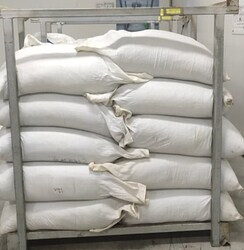Introduction
Target readers: solution engineers, layout planning engineers, mechanical design engineers, mechanism design engineers
Overview: This article focuses on the topic of sack stacking and destacking, detailing common challenges in the industry related to incoming sack materials and methods for addressing these challenges. It provides important guidance for the entire destacking solution design and the smooth progress of projects in the later stages.
1. Excessive Seal Edge of Sack

Specific issue: The excessively long seal edge of the sack (as shown in the picture above) affects the recognition of the sack’s center, causing offset in the sack’s pick point calculated. If downstream processes (such as sack depalletizing) require specific pick points on the sack, the excessive seal edge will impact the accuracy of picking.
Strategy: First, constrain the length of the sack’s seal edge. If it cannot be constrained, request the integrator or the customer to install sensor detection mechanisms or mechanical alignment devices before the depalletizing process. These mechanisms can be used to locate sack center points.
2. Inconsistent Orientation of Sacks

Specific issue: The orientation of incoming sacks on-site is inconsistent. Integrators or customers require the vision system to recognize the orientation of sacks based on certain features (including patterns, text, seal edges, etc.).
Strategy: During the project evaluation phase, train and test the deep learning model. Based on the test results, sack types, and sack features, assess the feasibility of this requirement.
3. Complex or Highly Reflective Patterns on Sack Surface

Issue: The patterns on the surface of the sack are overly complex or highly reflective, severely affecting vision recognition. Complex patterns can cause the vision system to erroneously merge the patterns of tightly stacked adjacent sacks into one, leading to incorrect results. Similarly, excessive surface reflection on sacks can result in defective point cloud data, making it impossible to generate accurate results.
Strategy:
(1) Remove sacks with severe reflections.
(2) If dealing with sacks with complex patterns, deploy deep learning in advance. Conduct multiple rounds of model training and on-site testing to further validate the feasibility of the deep learning model.
4. Sack Being Half-filled or Not Fully Packed

Issue: Sacks that are not completely filled can lead to decreased stability and uniformity of the stacked sacks. This situation might cause misalignment during sack opening and result in a high rate of leftover after depalletizing.
Strategy:
(1) Before entering the depalletizing station, manually remove half-filled and unfilled sacks.
(2) After the sack opening process, manually handle sacks containing leftover contents.
Note: If the customer does not have specific requirements for picking accuracy or rate of leftover content after the sack opening process, these issues do not need to be considered.
5. Tray Crossbeam Obstructing Field of View

Issue: As depicted, the sack tray is constructed with an integral cage or framework made of welded steel pipes. During image capturing, the upper crossbeam can easily obstruct the camera’s field of view. When picking the sacks, the pillars on all four sides might collide with the robot or gripper.
Strategy: This type of setup is not suitable for typical sack handling scenarios. Exercise caution and conduct a careful assessment. If such a scenario is unavoidable, comprehensive simulation and testing should be carried out in the early stages of the project. Coordinate with integrators or clients to establish the stack type and height. Plan the robot’s picking path sensibly to ensure there is no interference with the cage or framework during picking.
6. Irregular Placement of Sacks

Issue: Sacks on the stack appear tilted, stacked on top of each other, or standing on their sides, severely affecting recognition and picking.
Strategy: Standardize sack stacking patterns with the following guidelines:
(1) Sacks should be neatly placed flat.
(2) Sacks on the same layer should have consistent heights, avoiding tilting or stacking.
(3) Different layers should be tight together, ensuring the stability of the entire sack stack.
Summary of Principles Incoming Sacks:
(1) Sack seal edges should not be excessively long.
(2) Surface patterns on sacks should be simple and easy to recognize.
(3) Avoid excessive gloss or reflection on the sack surface.
(4) Prevent sacks from being half-filled.
(5) Maintain consistent orientation of sacks.
(6) Sacks should be placed flat, avoiding cross-layer stacking or exceeding the pallet.
(7) Sack stack type should be stable and reliable.
(8) Sack stack type and height should be consistent.
(9) Outer packaging material of sacks should be sufficiently sturdy.
(10) Remove interfering materials such as wrapping film and plastic wrap before depalletizing.
(11) Exercise caution when evaluating cage or frame-shaped pallets.
